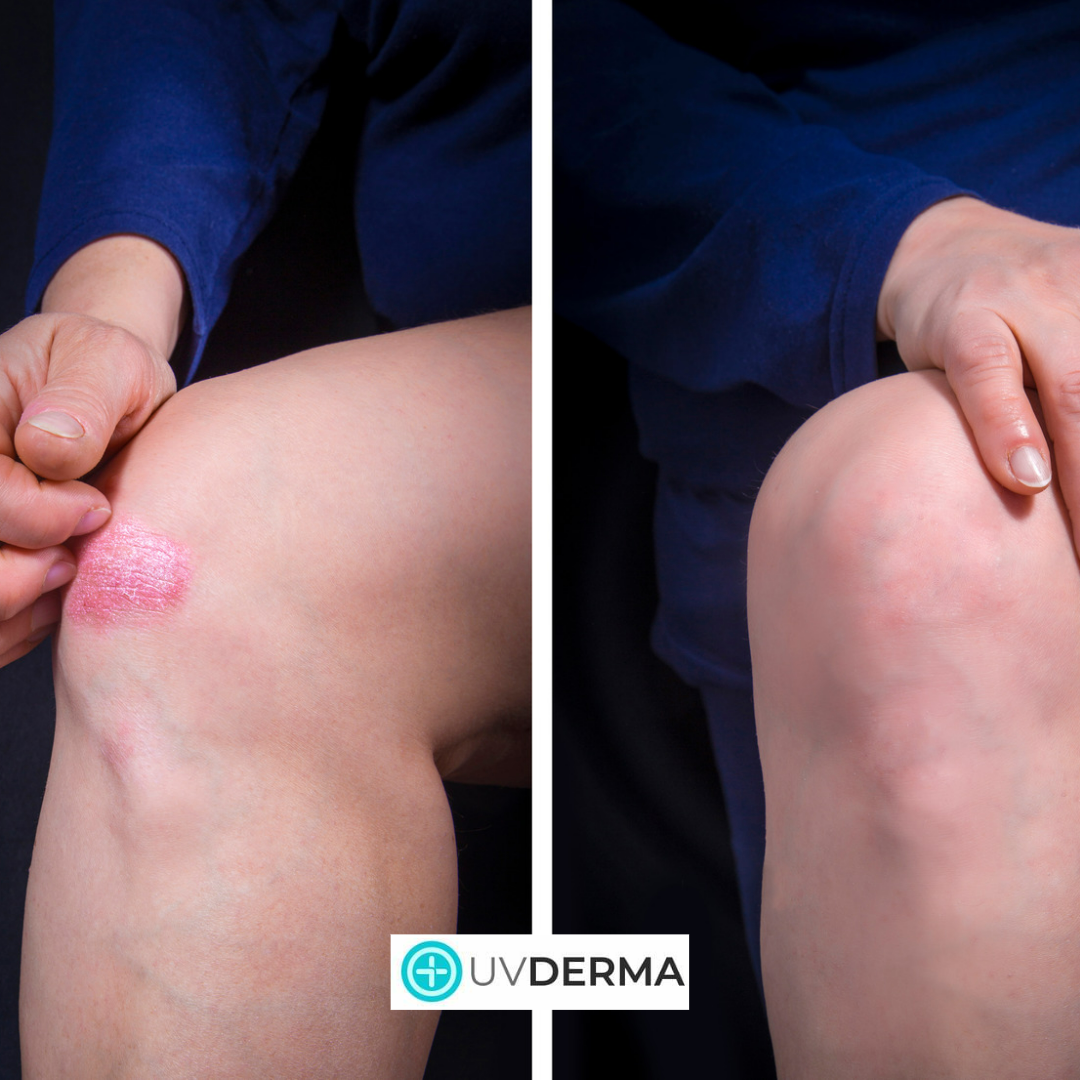UVB phototherapy is a treatment method that uses ultraviolet B (UVB) light to treat various skin conditions such as psoriasis, vitiligo, eczema and other skin conditions that react positively to UVB.
- Psoriasis: UVB therapy is one of the most effective treatments for psoriasis. It helps slow down skin cell growth and reduce inflammation, which can help clear psoriasis plaques and improve symptoms such as redness, itching, and scaling.
- Vitiligo: UVB therapy can be used to repigment the white patches of skin caused by vitiligo.
- Eczema (Atopic Dermatitis): UVB therapy reduces the itching and redness caused by eczema.
- Mycosis fungoides: UVB therapy can effectively treat mycosis fungoides, a cutaneous T-cell lymphoma.
- Other skin conditions that may respond positively to UVB therapy include, but are not limited to, polymorphous light eruption, lichen planus, and cutaneous T-cell lymphoma.
It's important to note that UVB light therapy is not suitable for everyone and should only be carefully administered at home or under the supervision of your healthcare professional. If you have any skin condition, you should first speak with your GP or dermatologist to determine if UVB light therapy is the proper treatment for you.
Is home-based UVB phototherapy safe?
Home-based UVB phototherapy can be safe and effective when used correctly and, where possible, be under the guidance of a dermatologist or healthcare professional. Some certain risks and precautions should be taken and considered when using UVB light therapy at home:
- Always wear protective eyewear while using the UVB light, and apply sunscreen to any exposed skin before and after treatment, especially if you live in a warmer climate.
- Do not use UVB light therapy if you take certain medications, such as tetracyclines or photosensitizing agents, or if you have certain medical conditions, such as lupus or porphyria, without consulting your dermatologist.
- It's essential to keep a record of your treatment schedule and progress and to notify your dermatologist of any changes or side effects.
- It's essential to use a UVB light device specifically designed for home use and follow the manufacturer's instructions.
- Keep the UVB device out of reach of children and pets, and turn off the device after use.
- Make sure to replace the bulb as per the manufacturer's instructions, as UVB light output decreases over time.
It's important to note that UVB light therapy should be used under a strict schedule and with high levels of consistency. Always speak with your healthcare provider for guidance on whether UVB is the correct course of action for you.
How long does it take to see results?
The length of time it takes to see results with UVB phototherapy will vary depending on the skin condition being treated, the severity of the disease, the patient's skin type, and the dosage and schedule of the treatment.
For psoriasis, most users will see a real difference in their skin in around 4-6 weeks following the regime in the instructional handbook.
For vitiligo, it may take several months of treatment to see a noticeable improvement in pigmentation.
For eczema, patients may notice an improvement in symptoms such as itching and redness within a few weeks of starting UVB phototherapy.
How does UVB compare to different treatment methods?
UVB (ultraviolet B) therapy is one of the most effective treatments for psoriasis, vitiligo, eczema, and other skin conditions that respond positively to UVB.
Compared to other treatment methods, such as topical creams and ointments, UVB therapy can penetrate deeper into the skin and treat more significant areas of affected skin. UVB therapy can also target the underlying cause of the skin condition, which is often an overactive immune system. UVB therapy is also considered to have a lower risk of side effects than oral medications and biological therapy.
Compared to PUVA therapy (psoralen + UVA therapy), UVB therapy has fewer side effects and; however, PUVA therapy may be more effective for treating moderate to severe psoriasis.
Home-based UVB phototherapy can be a safe and effective treatment option for specific skin conditions, such as psoriasis, vitiligo, eczema, and other skin conditions that respond positively to UVB. However, it's essential to use a UVB light device specifically designed for home use and to follow the treatment schedule diligently for the best results.
Get in touch at any time info@uvderma.com.
Please note that the information provided in this blog post is for informational purposes only and is not intended as a substitute for professional medical advice, diagnosis, or treatment.
Always seek the advice of your physician or other qualified healthcare providers with any questions you may have regarding a medical condition.
Individual results may vary, and treatment outcomes are not guaranteed. Any mention of specific products or treatments is for informational purposes only and should not be considered an endorsement or recommendation by the author.

